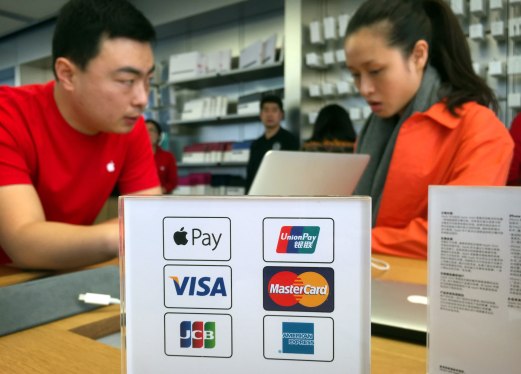
Editor’s Note
This post originally appeared on TechNode, an editorial partner of TechCrunch based in China.
After a slow start, Apple Pay is now dominating its home country, the United States. However, the same cannot be said for China, where it faces unique challenges. Data from Boston Retail Partners shows that Apple Pay is now accepted by 36% of merchants in the U.S., making it one of the most widely available mobile payment methods in the country.
However, to date, it has received a lukewarm reception in China, the world’s largest market for mobile payments. When Apple Pay first landed in the Middle Kingdom in May 2016, the smartphone giant was expected to make a significant dent in China’s highly consolidated mobile payment market. Things seemed to get off to a good start with more than 30 million bank cards added to Apple Pay during the first day of its official launch.
However, after close to one year of operations in China, Apple Pay has failed to become a genuine threat to the dominance of Alibaba’s Alipay and Tencent-backed Tenpay, which is embedded in dominant chat app WeChat Pay. The two leading payment services took 50.42% and 38.12%, respectively, of China’s mobile payment market share in Q3 last year, figures from research firm Analysys showed.
With the two leading payment services running a monopoly, the rest of the field recorded only single-digit shares of the market. Apple Pay did not even make it to the top ten with a portion of the market that is small enough to be overlooked. So, what’s happening here? These are some of the pitfalls standing in the way of Apple Pay in China.
QR Codes Rule
Technologically speaking, NFC used by Apple Pay enjoys many advantages over QR codes with its touch-and-go approach and built-in security. Yet, QR code payments have become a widely adopted and deep-rooted practice for Chinese users. Once these habits are formed en masse, they prove difficult to change.
Such is the ubiquity of QR codes that China UnionPay, one of Apple Pay’s Chinese partners and a long-time proponent of NFC, has even succumbed to pressure by launching its own QR code solution late last year. This was a pretty huge surprise given that UnionPay has made a big push into digital through partnerships with smartphone makers Huawei, Xiaomi, and, of course, Apple.
Overcoming Behavioral Trends
Building an initial mass of users ties back into behavioral trends, which can be very tough to overcome for a new kid on the block or a non-dominant service. The trend of using QR codes in China is deeply ingrained in the culture, and it will take significant effort from Apple Pay to change this.
Conclusion
Apple Pay’s struggle in China highlights the challenges of entering a highly competitive market with established players. While NFC offers many advantages over QR codes, the cultural significance of QR code payments in China cannot be overlooked. To succeed in China, Apple Pay needs to overcome these pitfalls and adapt to the local market’s unique characteristics.
Topics
- Apple
- apple inc
- Apple Pay
- apple store
- Asia
- China
- computing
- Fintech
- technology
Emma Lee is a Shanghai-based tech writer for Technode, covering startups and tech happenings in China and Asia in general.
Most Popular
- Meta execs obsessed over beating OpenAI’s GPT-4 internally, court filings reveal
- Google’s NotebookLM had to teach its AI podcast hosts not to act annoyed at humans
- TikTok users’ attempted migration to Chinese app RedNote isn’t going too well
- ChatGPT now lets you schedule reminders and recurring tasks
- Meta to cut roughly 5% of its workforce based on performance
- DOJ confirms FBI operation that mass-deleted Chinese malware from thousands of US computers
- OpenAI’s AI reasoning model ‘thinks’ in Chinese sometimes and no one really knows why
Newsletters
- TechCrunch Daily News: Get the best of TechCrunch’s coverage delivered to your inbox every weekday and Sunday.
- TechCrunch AITechCrunch’s AI experts cover the latest news in the fast-moving field. Get our best coverage delivered weekly.
- TechCrunch Space: Every Monday, get up-to-speed on the latest advances in aerospace.
- Startups Weekly: Startups are the core of TechCrunch, so get our best coverage delivered weekly.
Related
- FintechSoftBank veteran hunts for profits in payments infrastructure plumbing
- Nelly raises $51 million to digitalize medical practices across Europe
- Why some former Bench customers are not happy
This article highlights Apple Pay’s struggle in China, a country with a highly competitive market and deeply ingrained cultural trends. To succeed in China, Apple Pay needs to adapt to the local market’s unique characteristics and overcome the pitfalls of QR code payments.
References
- Boston Retail Partners
- Analysys
- TechNode
- Technode






